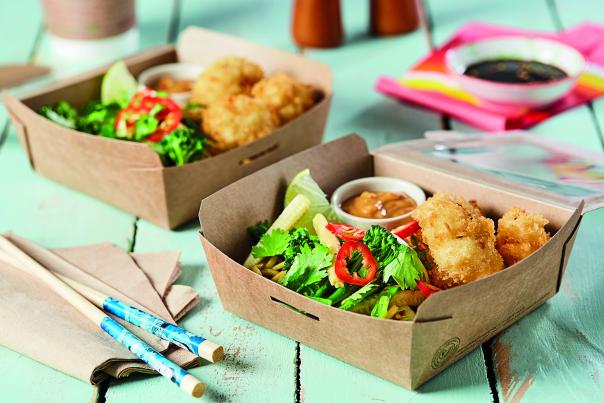
There are nine million children in schools across the UK, all of whom need to be served lunch in a short window, often lasting only 30 or 40 minutes.
Covid-19 has been a catalyst for changing the way children are fed, and this has meant new formats are becoming more popular among caterers, giving them added flexibility when it comes to the space pupils are fed in and the type of food they are served.
Street food-style dishes, which are synonymous with speed, are a great option for schools and can provide appealing, exciting options to rival what is on the high-street and in local retailers.
In fact, we often see popular retail and hospitality trends trickle down into the education space, where they are embraced by students, particularly at secondary school age, who want to eat something which mirrors current flavours and new and emerging cuisine influences.
Bowl food
Street food lends itself to the education catering space, as it’s designed to be eaten on the move, meaning caterers have new options when it comes to feeding children in different areas across a school site. Bowl food, which regularly features on street food menus out-of-home, has been trending for a while now, and its influence is making its way onto school menus.
Dishes that can be enjoyed from a single container – whether that be a melamine bowl or recyclable container – and that are hand-held or eaten with just a fork allow portability and therefore flexibility when it comes to the space it’s being consumed in.
East Asian influence- Japanese & Korean
In 2023 we expect to see East Asian food continue to grow in popularity in all settings and really start to have an impact on school food options too - with an expected rise in demand for dishes such as rice bowls, bao buns, dumplings and noodle-based dishes.
What’s fantastic about many of these dishes is that they all have a carbohydrate base, so are filling, but are made interesting by the layers of toppings that are added to them, often with flavoursome sauces to finish them dishes off – making them super versatile and adaptable.
The proteins that are used in rice bowls, for example, can be varied – with tofu easily substituted for chicken in toppings, creating an element of personalisation and choice too.
Regional Indian specialities
Indian food, with its huge range of evocative and vibrant flavours, continues to be popular in schools where curries often form part of the regular weekly revolving menu. Children in the UK, as well as their parents, are becoming more familiar with previously lesser-known dishes which may be influenced by regional flavours.
With an entire subcontinent to take influence from, even dishes featuring a tomato base can be incredibly varied and easily adapted. Think about pulling in flavours of coconut from South India, whilst richer, slightly spicier options can take influence from some of the North Indian dishes which are already so popular out-of-home.
Curry dishes can be incredibly cost-effective for school caterers and easily adaptable to the time of year – allowing for seasonal vegetables to be incorporated into dishes, in turn keeping costs down as much as possible.
Integrating street food into menus
Instead of having to continuously change dishes on menus, and create completely new recipes from scratch, a good way to keep things feeling new and exciting without a complete menu change is by varying the carrier – whether that’s the bread that’s being used, or the rice or noodles at the base of a dish.
Simply switching the base of a dish around can make it feel completely different. For example, marinated chicken satay could be served on a bed of steamed rice in a pot, in a sandwich or even layered in bao hirata buns. One protein, one flavour, three different dishes.
Additionally, varying how dishes are served physically and visually can drive appeal. While considerations should be made for the environmental impact of takeaway cartons, there are some fantastic recyclable options that will go hand-in-hand with the street food-style of serving.
Street food solution
One of the main factors that school caterers come up against is time; having the time to develop new recipe ideas, review menus and pair flavours with budgets.
There are increasing numbers of concepts out there, and at Creed Foodservice we’ve created our own street food solution – Kitchen ’72 – designed to support caterers create dishes that tick the boxes of taste, quality, health, are on-trend, quick to serve and are compliant with standards – whilst coming within the ever-important margins.
Creed’s team of development chefs, in partnership with Creed’s non-executive director Phil Vickery, have launched the first range of products that come under the Kitchen ’72 solution, with a new range of marinated chicken boxes, featuring nutritionally-balanced recipes based around five global marinade flavours – BBQ, satay, tandoori, Mexican and chermoula.
Each box is served with either a tortilla wrap or rice, marinated chicken, a side of slaw and finished with a drizzle of sauce. With speed at the top of the agenda, the new concept enables kitchens to serve 15 meals per minute, or 600 pupils over a 40-minute lunch break.